A New 30" Contender: HP ZR30w Review
by Brian Klug on June 1, 2010 6:30 PM EST
ZR30w Color Quality
We’ll start out with the color quality of the ZR30w. As per usual, we report two metrics: color gamut and color accuracy (Delta E). Color gamut refers to the range of colors the display is able to represent with respect to some color space. In this case, our reference is the AdobeRGB 1998 color space, which is larger than the sRGB color space. So our percentages are reported with respect to this number, and larger is better.
Color accuracy (Delta E) refers to the display’s ability to display the correct color requested by the GPU. The difference between the color represented by the display, and the color requested by the GPU is our Delta E, and lower is better here. In practice, a Delta E under 1.0 is perfect - the chromatic sensitivity of the human eye is not great enough to distinguish a difference. Moving up, a Delta E of 2.0 or less is generally considered fit for use in a professional imaging environment - it isn’t perfect, but it’s hard to gauge the difference. Finally, Delta E of 4.0 and above is considered visible with the human eye. Of course, the big consideration here is frame of reference; unless you have another monitor or some print samples (color checker card) to compare your display with, you probably won’t notice. That is, until you print or view media on another monitor. Then the difference will be very apparent.
As I mentioned in our earlier reviews, we’ve updated our display test bench. We’ve deprecated the Monaco Optix XR Pro colorimeter in favor of an Xrite i1D2 since there are no longer up-to-date drivers for modern platforms. We’ve also done testing and verification with a Spyder 3 colorimeter. We’re using the latest version of ColorEyes Display Pro - 1.52.0r32, for both color tracking and brightness testing.
We’re providing data from other display reviews taken with the Monaco Optix XR alongside new data taken with an Xrite i1D2. They’re comparable, but we made a shift in consistency of operator and instrumentation, so the comparison isn’t perfect. It’s close, though.
For these tests, we calibrate the display and try to obtain the best Delta E we can get at both 200 nits and 100 nits (print brightness). We target 6500K and a gamma of 2.2, but sometimes performance is better using the monitor’s native measured whitepoint and gamma. We also take uncalibrated measurements that show performance out of box using the manufacturer supplied color profile. For all of these, dynamic contrast is disabled. The ZR30w has no other controls save brightness, which we manually adjust to hit our 200 nit and 100 nit targets.
So, how does the ZR30w do? Let’s dive into the charts:
We’ll start out with the color quality of the ZR30w. As per usual, we report two metrics: color gamut and color accuracy (Delta E). Color gamut refers to the range of colors the display is able to represent with respect to some color space. In this case, our reference is the AdobeRGB 1998 color space, which is larger than the sRGB color space. So our percentages are reported with respect to this number, and larger is better.
Color accuracy (Delta E) refers to the display’s ability to display the correct color requested by the GPU. The difference between the color represented by the display, and the color requested by the GPU is our Delta E, and lower is better here. In practice, a Delta E under 1.0 is perfect - the chromatic sensitivity of the human eye is not great enough to distinguish a difference. Moving up, a Delta E of 2.0 or less is generally considered fit for use in a professional imaging environment - it isn’t perfect, but it’s hard to gauge the difference. Finally, Delta E of 4.0 and above is considered visible with the human eye. Of course, the big consideration here is frame of reference; unless you have another monitor or some print samples (color checker card) to compare your display with, you probably won’t notice. That is, until you print or view media on another monitor. Then the difference will be very apparent.
As I mentioned in our earlier reviews, we’ve updated our display test bench. We’ve deprecated the Monaco Optix XR Pro colorimeter in favor of an Xrite i1D2 since there are no longer up-to-date drivers for modern platforms. We’ve also done testing and verification with a Spyder 3 colorimeter. We’re using the latest version of ColorEyes Display Pro - 1.52.0r32, for both color tracking and brightness testing.
We’re providing data from other display reviews taken with the Monaco Optix XR alongside new data taken with an Xrite i1D2. They’re comparable, but we made a shift in consistency of operator and instrumentation, so the comparison isn’t perfect. It’s close, though.
For these tests, we calibrate the display and try to obtain the best Delta E we can get at both 200 nits and 100 nits (print brightness). We target 6500K and a gamma of 2.2, but sometimes performance is better using the monitor’s native measured whitepoint and gamma. We also take uncalibrated measurements that show performance out of box using the manufacturer supplied color profile. For all of these, dynamic contrast is disabled. The ZR30w has no other controls save brightness, which we manually adjust to hit our 200 nit and 100 nit targets.
So, how does the ZR30w do? Let’s dive into the charts:
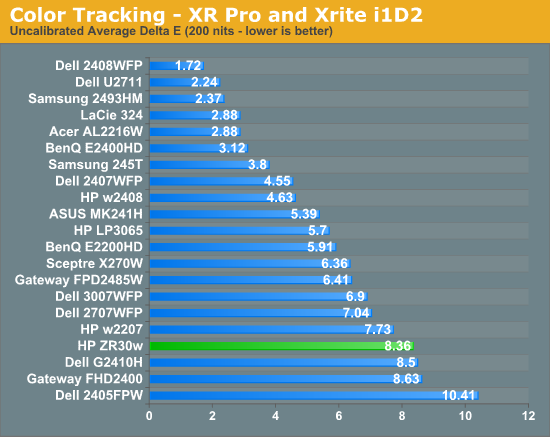
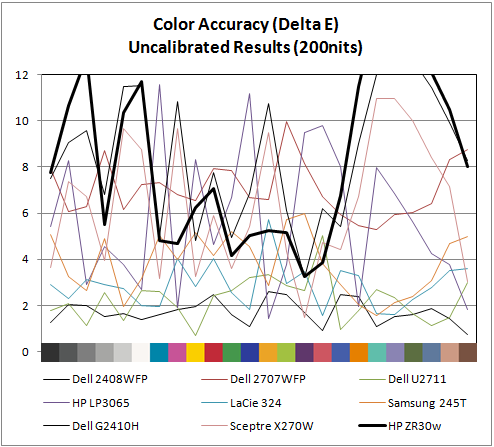

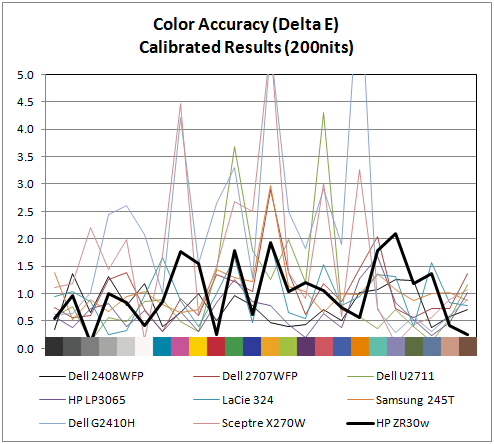
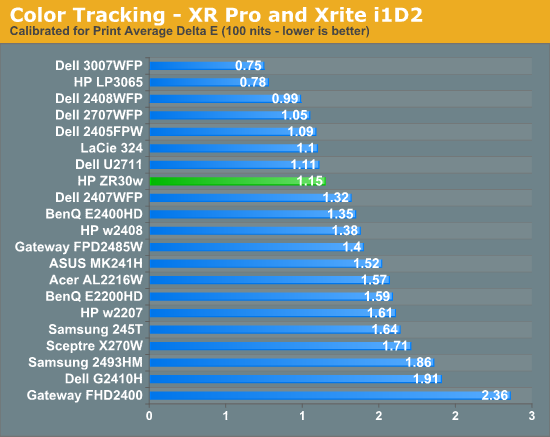
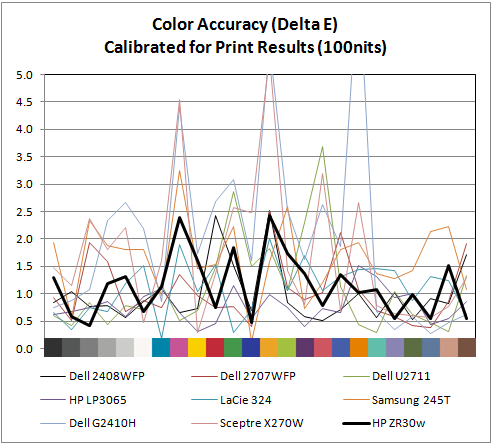
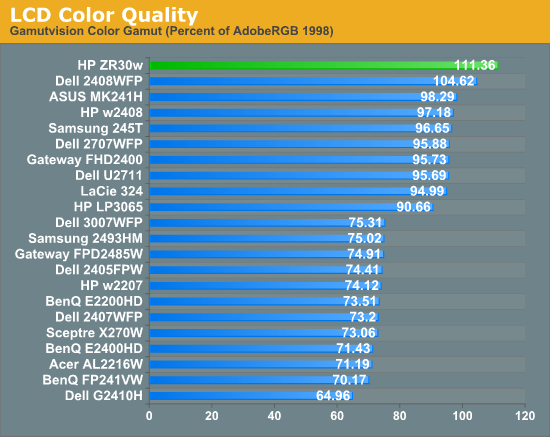
Out of box, the ZR30w looks a tad cool in temperature and is very vibrant. Perhaps even too vibrant, but then again maybe that's what 1 billion colors looks like. I’m a bit surprised that uncalibrated performance isn’t better than what I measured. I ran and re-ran this test expecting something to be wrong with my setup - it just doesn’t perform very well in this objective uncalibrated test. That isn’t to say it doesn’t look awesome - it does - but the ZR30w strongly benefits from calibration.
Moving to calibrated performance at 200 nits, the ZR30w really starts to deliver, with impressive Delta E of 1.01. Pay attention to the charts, there's not a single peak above 2.0, which is awesome. I couldn’t get the ZR30w all the way down to 100 nits - the lowest the display will go is right around 150 nits. Surprisingly, Delta E actually gets a bit worse, and moves up to 1.15 at the dimmest setting. Interestingly, the highest peak jumps up to 2.5 at this brightness. I’ll talk more about brightness in a second, but it’s pretty obvious that the ZR30w wants to be bright. You can just tell from the dynamic range you can get to in the menus, from 150 nits up to the maximum around 400, and it’s somewhere inbetween there that Delta E really really shines.
Of course, the ZR30w delivers in color gamut. Note that in the volumetric 3D plot, the wireframe plot is the ZR30w, and the solid plot is AdobeRGB 1998 - that’s right, we’ve exceeded the AdobeRGB color space. The raw data is impressive, the display manages 111.36% of coverage, the highest we’ve tested. In this case, we’ve exceed the manufacturer claims of 99% AdobeRGB by a notable margin. I have no trouble believing that HP's claims about 1+ billion colors are totally accurate - you have to see it in person to believe it. There are just some colors I'm used to not seeing represented very well; reds and blues especially, and the photos that I have looked at are spectacular.
IPS panels are still very, very win. It’d be awesome to see a Delta E under 1.0, but I just couldn’t get that from the ZR30w I tested. The additional difference would of course be absolutely indistinguishable to the human eye, but it’d be an awesome bragging right. But you've already got more than a billion colors.
Moving to calibrated performance at 200 nits, the ZR30w really starts to deliver, with impressive Delta E of 1.01. Pay attention to the charts, there's not a single peak above 2.0, which is awesome. I couldn’t get the ZR30w all the way down to 100 nits - the lowest the display will go is right around 150 nits. Surprisingly, Delta E actually gets a bit worse, and moves up to 1.15 at the dimmest setting. Interestingly, the highest peak jumps up to 2.5 at this brightness. I’ll talk more about brightness in a second, but it’s pretty obvious that the ZR30w wants to be bright. You can just tell from the dynamic range you can get to in the menus, from 150 nits up to the maximum around 400, and it’s somewhere inbetween there that Delta E really really shines.
Of course, the ZR30w delivers in color gamut. Note that in the volumetric 3D plot, the wireframe plot is the ZR30w, and the solid plot is AdobeRGB 1998 - that’s right, we’ve exceeded the AdobeRGB color space. The raw data is impressive, the display manages 111.36% of coverage, the highest we’ve tested. In this case, we’ve exceed the manufacturer claims of 99% AdobeRGB by a notable margin. I have no trouble believing that HP's claims about 1+ billion colors are totally accurate - you have to see it in person to believe it. There are just some colors I'm used to not seeing represented very well; reds and blues especially, and the photos that I have looked at are spectacular.
IPS panels are still very, very win. It’d be awesome to see a Delta E under 1.0, but I just couldn’t get that from the ZR30w I tested. The additional difference would of course be absolutely indistinguishable to the human eye, but it’d be an awesome bragging right. But you've already got more than a billion colors.


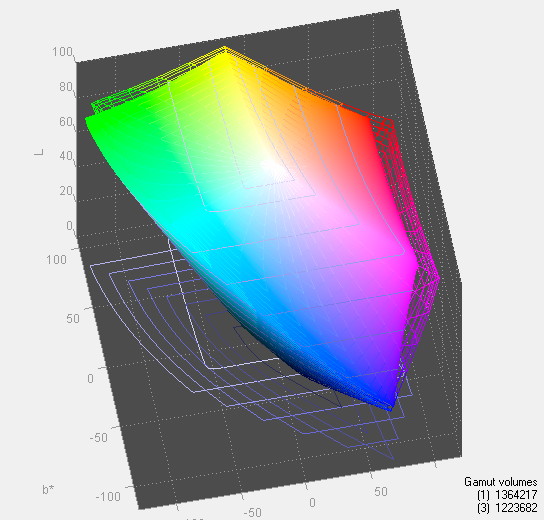








95 Comments
View All Comments
mcklevin - Monday, June 28, 2010 - link
I now have had this monitor for a week, and it has performed quite well, it is a very solid professional looking build. The anti-glare screen does not sparkle like the LG screen, and the black levels are better as well. Text looks much better than the LG too.Right now I do not have a calibrator. The color accuracy is pretty good, It does get hot it the high end like many of the wide gamut monitors. Dropping the digital vibrancy to 44 in the nvidia control panel has helped a lot with the saturation. The viewing angles are nice, horizontal I would give an 9, vertical 7. I didn't notice input lag in Mass Effect 2. I use this monitor for Cinema 4D and Aftereffects.
AlphaJarmel - Wednesday, June 23, 2010 - link
So this monitor is pretty much useless for gaming as Windows will ignore the calibration.SoCalRich - Thursday, July 1, 2010 - link
Brian,Thanks for your review!!!
I have a new 17" MacBook Pro i7. I was curios if you were able to hook up your MBP to this monitor using the displayport cable?
I think this would be a great monitor for my Photoshop & Lightroom editing. I've been looking at the 30" ACD. This looks like a better monitor.
I'm still a little confused about how you make any adjustments w/o OSD????
SoCalRich - Thursday, July 1, 2010 - link
My new 17" MacBook Pro i7 uses the Intel HD Graphics for regular web surfing etc. It then switches to the NVIDIA GeForce GT 330M when I open Photoshop and Lightroom.I'm hoping these cards will support this monitor using the displayport cable.
tsittard - Saturday, July 3, 2010 - link
I picked this monitor up for a 3rd editing monitor to be used with Final Cut Pro, AJA Kona 3 card, and a blackmagic conversion box that goes from HD-SDI to dual link dvi-d.Here's the link:
http://www.blackmagic-design.com/products/hdlink/t...
I'm not getting any picture....
I'm currently using the zr30w as a second computer monitor, which is working fine at 2500x1600 coming off my Mac Pro, but this is not what I intended...
Is it not possible to send this monitor a 1920x1080 signal via dvi-d and have it upscale to fill it?
I'm also using 2 hp zr24w's for my computer monitors, and I've hooked up the blackmagic box to one of those and everything works great...
My settings inside of FCP are for a 1080 23.98psf 10bit signal, again it seems to work fine going into the ZR24w
I sense that there should be a simple answer here but I'm not finding it....
the blackmagic converter box also comes in a display port version, will that allow me to send the HD resolution to the zr30w?
Mr. Klug, any suggestions?
B3an - Tuesday, August 10, 2010 - link
Brian - you mentioned you used to i1 Display 2 to calibrate this monitor, i have both this monitor and the i1D2, can you tell me what settings you used?I find if a default white point is not selected then the colours and especially greys have a red tint to 'em. Did you try it with the Eye-One Match 3 software that comes with the i1D2? Thanks.
humba - Sunday, August 15, 2010 - link
Has anyone who actually got the monitor noticed a buzzing/humming noise coming from the screen as soon as there's a video input signal?The noise is similar to the feedback noise you get on an audio system if there's an issue with the grounding, and it only goes away if the brightness is increased to 80% or higher.
I've already RMA'ed my device once (they sent out a replacement only hours after receiving the case which makes me thing it's a known defect), but the replacement exhibits the exact same behavior. I've gone through a bunch of different DP cables, tried with various DVI cables, too, on 4 different computers (HP EliteBook 8540p, Acer Timelize 3810TZ, Mac Mini 2009 and a self-assembled box) and went around the house trying different electrical phases but to no avail.
And I seem not to be the only one since I found this test that mentions the same issue: http://www.productwiki.com/hp-zr30w/. And, strangely enough, the support documents at HP's site also has a support document (albeit a very old one ): http://h20000.www2.hp.com/bizsupport/TechSupport/D... which doesn't really have any relation to the display in question other than the 80% brightness mentioned which seems to be the fix from 2003 on.
martinz - Tuesday, November 1, 2011 - link
Yes. Mine did it, got it replaced, same issue.HP in the US confirmed they all do it below 80% brightness, but tried to claim all/most large panels do it.
I think it is completely unacceptable for a monitor at this price - and I am shocked that HP don't agree. Otherwise, I like it a lot: great picture and build quality.
In a busy office it would not be noticeable, and if you can live with the (for me) eyeball melting full brightness, or are not sensitive to ambient noise, it's not an issue either.
For me it's a show stopper. Mine is going back, but not sure what to replace it with.
BikeDude - Friday, August 27, 2010 - link
Do all displays support HDCP these days, or will I still need AnyDVDHD in the future if I have to replace my current 30" Apple Cinema display?fontajos - Monday, September 13, 2010 - link
Hi Brian,thanks for your extensive test on the HP Z30w. I just bought the z30w and was very disappointed by the strong blue at 9000 Kelvin. I installed the hp ICM profile but nothing changed. I want to have a 6500K screen (like all other monitors here). Is it possible to send me your ICM file or can you suggest me a way to get my white to real-white and not blueish-white? If the only solution is to use a hardware calibration, can you suggest me a product?